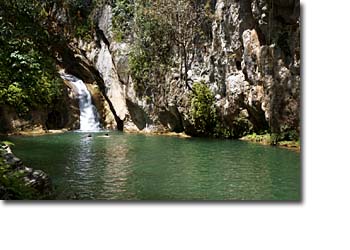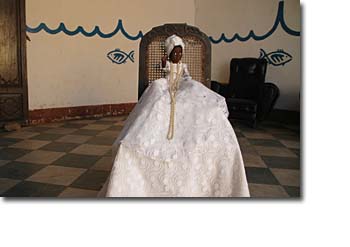Bazaar Trinidad
Calle Antonio Maceo, Trinidad, Cuba
Casa Regidor
Art Gallery
Casilda
Harbor
Embalse Hanabanilla
Between Trinidad and Santa Clara
Weir lake
Museo de Arqueología y Ciencias Naturales
Simón Bolívar #457, Trinidad, Cuba
Tel: +53 419 3420
A 18th-century building remodeled in 1835. It became a museum in 1976.
Exhibitions variates from Pre-Colombian culture to local flora and fauna, sometimes bit boring. The German explorer Alexander Von Humboldt stayed in this house during his trip to Cuba in 1801.
 Iglesia Parraquial de la Santisima Iglesia Parraquial de la Santisima
(The Holy Trinity Church)
At the Plaza Mayor, Trinidad, Cuba
Historical center
Better known as Parroquial Mayor, anno 1892. The interior is very simple Victorian-Gotical with an impressive altar beautifully decorated. According to bibliographical accounts, it was in that church where the first Baptismal registration of a white people took place in 1514. Its altar made of finest wood substituted the traditional marble. |
 Torre del Antiguo Ingenio Manacas-Iznaga Torre del Antiguo Ingenio Manacas-Iznaga
Carretera de Trinidad a Sancti Spíritus
Trinidad Cuba
Pedro Iznaga built a sprawling hacienda in the middle of the San Luis Valley with the fortune he made from the slave trade. He erected a 44-meter high watch tower with 184 steps, some 50 meters from the main house, to control the slaves who were more than willing to escape. He would also mark the hour by tolling a bell. The vernacular and industrial-style tower has become a symbol of this legendary region, despite its contrast with the surrounding area. It does in fact allow for a panoramic view of Trinidad. |
 Mesón del Regidor Mesón del Regidor
(The Tavern of the Regidor)
A mansion from the first half of the 18th century. Former residence of the town's Regidor Ortiz.
Its mural is believed to be one of the city's first ones. Today one of the most coziest hotels in Trinidad and a nice place to have a drink or lunch |
 Museo Historico Principal Museo Historico Principal
Bolivar #423, e/ Francisco Gomez y Gustavo Izquierdo
Trinidad, Cuba
Tel: +53 419 4460
(closed on Friday)
A stylish furnished building. It will tell you the history of all kind of historical objects and the family who lived here in earlier times.
From the tower which is quiet a climb you have a stunning view and the perfect location for taking pictures of the historical center of Trinidad. |
Plaza Carrillo
(Carrillo Square)
Became a relevant place for entertainment and leisure in 1840, after a process of organization in the city of Trinidad took place during the 18th century. Since then, the square has been paved, grated and also restored totally. Several important buildings of the city surround it as the current headquarters of the local Government.
 Plaza Mayor Plaza Mayor
Since Trinidad's beginnings and like most cities founded by the Spaniards—the relevant institutions were clustered round the city's central plaza. From 1514 onward, this plaza has undergone changes, until more than 300 years later it finally took on its present appearance. During the 19th century, the main Cathedral as well as mansions and palaces of the landed families of Brunet, Padrón, Ortiz and Sánchez-Iznaga's were situated here. Today, most of these building house museums and the plaza is quaintly decorated with four gardens surrounded by fences from Philadelphia, street lamps and a statue of the Greek muse, Terpsicore, in its center. |
 Plaza de Santa Ana Plaza de Santa Ana
(Saint Ana Square)
Ancient Royal Jail built in 1844.
At present, it is a cultural center of great significance in the city.
|
 San Francisco de Assisi Convent San Francisco de Assisi Convent
It started to be built in 1770, and concluded in 1813. It was demolished earlier last century, when only its tower survived. However, some years later it was rebuilt under its original design. In 1986, the convent finally became the Museum of the Cuban People's Struggle against the Counterrevolution.
|
Museo de la Lucha Contra Bandidos
Fernando Hernández Echerri #59 close at Piro Guinalt Trinidad
Open: 9am - 5pm Tue - Sun
(closed on Monday)
This museum is located in the former convent and church of San Francisco de Asís, built in 1770 and finished in 1913. During the first decades of the 20th century it was demolished and only its tower remained. It was later rebuilt as it appears today. In 1986 the convent became the "Museum of the Struggle against Bandits". Documents, photos, maps, weapons and belongings of the main participants in these battles are exhibited.
Semana de la Cultura Trinitaria
These past few years Trinidad's cultural week has been celebrated during the second week of January. The date was moved to coincide with the commemoration of the city's founding. Throughout the seven-day long festivities, the city displays its best cultural traditions. Artisans, potters and painters exhibit their best work. Locations around the city open their doors for concerts and folkloric groups perform outside of their usual stages.
The Three Crosses neighborhood
Its urbanization began during the 18th century along with the expansion of the city.
Its real name is Calvary neighborhood. Although today is name is The Three Crosses Plaza. The Three Crosses neighborhood becomes a relevant place in Trinidad during the traditional religious processions of the Holy Week
 Topes de Collantes Topes de Collantes
Beautiful nature in the Escambray mountains. Many tourist offices in Trinidad can help you for a tour to this great area of Cuban nature.
You can find more information about Topes de Collantes and other nature areas around Trinidad to check out the link below ... |
Valley of the Sugar mills
A World Heritage Site. This beautiful green plateau was home for old sugar mills.
The Valley is a wonderful Cuban landscape outstanding for its archaeological and architectural treasures, as well as its areas of incredible wilderness.
Museo Romántico
Fernando Hernández Echerri #52, near Calle Simon Bolivar, Trinidad, Cuba
Tel: +53 419 4363
(closed on Monday)
Loaded with antique furniture, witnesses of the wealthy 18 century in Trinidad. As well as inside the building itself, beautiful tiles!
Museo de Arquitectura Colonial
Plaza Mayor, Calle Cispalda #83 e/ Cristo y Plaza Real del Jigue, Trinidad, Cuba
Tel: +53 419 3208
(closed on Friday)
Former mansion of the Sánchez Iznaga family.
It was built in 1738, and restored in 1836. The 18th-century household opened as the Museum of Architecture of Trinidad, in 1979
|








 Centro Historico de Trinidad
Centro Historico de Trinidad Antigua Villa de la Santísima Trinidad
Antigua Villa de la Santísima Trinidad Brunet Theater Ruins
Brunet Theater Ruins  Iglesia Parraquial de la Santisima
Iglesia Parraquial de la Santisima  Torre del Antiguo Ingenio Manacas-Iznaga
Torre del Antiguo Ingenio Manacas-Iznaga Mesón del Regidor
Mesón del Regidor  Museo Historico Principal
Museo Historico Principal Plaza Mayor
Plaza Mayor  Plaza de Santa Ana
Plaza de Santa Ana San Francisco de Assisi Convent
San Francisco de Assisi Convent Topes de Collantes
Topes de Collantes